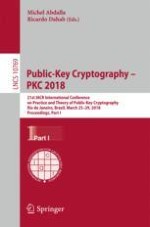2018 | OriginalPaper | Buchkapitel
Equational Security Proofs of Oblivious Transfer Protocols
verfasst von : Baiyu Li, Daniele Micciancio
Erschienen in: Public-Key Cryptography – PKC 2018
Aktivieren Sie unsere intelligente Suche, um passende Fachinhalte oder Patente zu finden.
Wählen Sie Textabschnitte aus um mit Künstlicher Intelligenz passenden Patente zu finden. powered by
Markieren Sie Textabschnitte, um KI-gestützt weitere passende Inhalte zu finden. powered by
